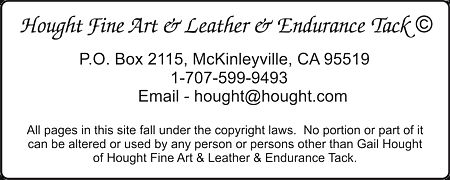|
2/11/03
SUPPLING
Suppling is overlooked and under developed
by most riders. It starts on the ground and transitions to riding.
If your horse is difficult to "correct" while you are
mounted, dismount and "soften" the area of focus. You
are safer on the ground than the risk of falling from the horse
or running into an obsticle. If you are not sure, get help. We
usually supple one or maybe two parts and get lazy, in a hurry,
forget or ignore the other areas. We can group the body into
5 areas of control: (1) head and neck (2) poll (3) shoulders
(4) ribs (5) hips. Once we have complete control of these five
parts we will have control of the horses feet. Who ever controls
the feet, controls the mind. If the horse feels like butter between
your legs and in your hands, he is supple.
The mouth is a "signal station"
receiving and sending signals. It will be soft and relaxed if
you and your hands are soft and relaxed.
The reins send signals and control the head, neck and 50% of
the feet. Your feet and legs control the barrel and hips of the
horse and the other 50% of the horses feet.
We want our horse to be soft, supple, responsive and relaxed
so, our task is to learn how to prepare each part of the horse.
Lateral flexion is the key to vertical flexion and the most common
error made while working on this is loss of forward momentum
and poor rider release. The release by the rider for any try
by the horse is key to softness. Remember the all or nothing
concept? It is almost like a game between the horse and you.
Who can release the quickest? You can feel it coming through
the reins, so beat him to it.
Resistance increases as speed increases. So speed is what we
slowly build towards. Take everything slowly and give the horse
time to figure out the correct response. Once he begins to get
the idea, your horse is on his way to success. How long do you
think it will take for it to become a habit for the horse? Well,
how long did it take you to learn how to perform long division?
You can figure that it will take 4-6 months for it to become
a habit for the horse, if you are consistant. Time is overlooked
because we are impatient and assume that if the horse does it
once that they have it forever. Wrong! Our consistancy and feel
are another key that we get lazy about. We have a tendency to
get lazy about consistency and don't pay attention to feel.
Your suppling routine must be done everytime you ride your horse.
As you practice this, it becomes a habit for you and your horse
and takes less time. All you are doing is testing for any "hard
spots" to soften. If there are none, it may take only a
few moments. If you find a hard spot, "fix it immediately,"
because it will grow, take longer and become more difficult to
correct. Your ability to "feel" the little hard spot
will become more acute, detected sooner and "fixed"
more easily. Try thinking, "first things first."
The suppling process is ongoing and must be addressed anywhere
and anytime the horse shows a "hard spot." The first
correction, "fix," might present itself when you go
to the stall to catch your horse and he turns and puts his head
in the corner. What do you do? Fix it or "just get by"
and not corrrect the problem. If you don't fix it here, you are
sending the message the horse is in control and he will not respect
you. Use your head to cause him to respect you. Put him to work
right then and there. This does not mean to get mad and whip
him, just make him move around and work. Remember, he wants to
be comfortable. How comfortable is he if he is working by moving
around until "you" let him stop? That's the beginning
of a good ride. If you address that problem "everytime"
it presents itself, it will appear less and less. You have created
the good habit, of him facing you when you go to the stall to
catch him. Making him work, if he won't face you, sends a message
to him that it is easier to face you so he won't have to work
first. Remember, a horse is a creature of habit and wants to
be comfortable. You are teaching him to respect you. |
